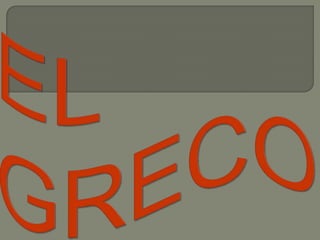
Greco y arquitectura herreriano
- 1. EL GRECO
- 2. El Greco was born in Crete, which was at that time part of the Republic of Venice, and the centre of Post-Byzantine art. He trained and became a master within that tradition before travelling at age 26 to Venice, as other Greek artists had done. In 1570 he moved to Rome, where he opened a workshop and executed a series of works. During his stay in Italy, El Greco enriched his style with elements of Mannerism and of the Venetian Renaissance. In 1577, he moved to Toledo, Spain, where he lived and worked until his death. In Toledo, El Greco received several major commissions and produced his best known paintings.
- 4. The primacy of imagination and intuition over the subjective character of creation was a fundamental principle of El Greco's style. El Greco discarded classicist criteria such as measure and proportion. He believed that grace is the supreme quest of art, but the painter achieves grace only if he manages to solve the most complex problems with obvious ease. El Greco regarded color as the most important and the most ungovernable element of painting, and declared that color had primacy over form. Francisco Pacheco, a painter and theoretician who visited El Greco in 1611, wrote that the painter liked "the colors crude and unmixed in great blots as a boastful display of his dexterity" and that he believed in constant repainting and retouching in order to make the broad masses tell flat as in nature". "Iholdtheimitationofcolortobethegreatestdifficultyof art."
- 6. The Herrerian architecture, or Herrerian style is characterized by its geometric rigor, the mathematical relation between the various architectural features, the clean volumes, the dominance of the wall over the span and the almost total absence of decoration, which is why in time was called desornamentadedstyle. Is also known as escorial style, referring to the building that serves as best example for the architectural style. The Herrerian buildings are noted for its severe horizontality, achieved through the balance of forms, preferably cubic, which are arranged symmetrically in the structure. Usually have wooden roofs covered with slate in the exterior and side towers, tipped with pointed toes pyramidal spire, which introduce an element of verticality, while helping to reinforce the sense of symmetry.
- 8. THEEND